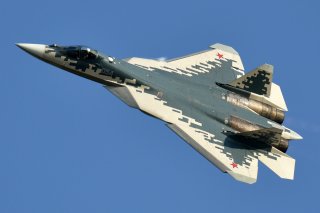Trouble Time: Russian Su-57s Could Start Carrying Hypersonic Missiles
America's F-35 could be in for a rough time.
Here's What You Need to Remember: It is not surprising that the Russian air force would pursue ways to package its latest missile capabilities together with its cutting-edge jet technology. Russia’s integration of hypersonic missiles with fifth-generation stealth capabilities could yield considerable dividends in its threat projection capacity.
Last year, The National Interest discussed the possibility of Russia’s fifth-generation stealth fighter being outfitted with hypersonic Kinzhal missiles. Russian state news reported Kinzhal integration on the Su-57 earlier this week: "In accordance with Russia's State Armament Program for 2018-2027, Su-57 jet fighters will be equipped with hypersonic missiles. The jet fighters will receive missiles with characteristics similar to that of the Kinzhal missiles, but with inter-body placement and smaller size," says a defense industry insider.
The prospect of hypersonic missiles on the Su-57 was previously teased by Boris Obnosov, general director of the Tactical Missiles Corporation (KTRV): “In perspective, we can certainly anticipate this [hypersonic] weaponry over the following decade. Everything will come in due time for the Su-57, likely including hypersonic weapons.”
The Kh-47M2 Kinzhal is a nuclear-capable, hypersonic missile unveiled by Russian President Vladimir Putin at a high-profile speech in early 2018: “The missile flying at a hypersonic speed, 10 times faster than the speed of sound, can also maneuver at all phases of its flight trajectory, which also allows it to overcome all existing and, I think, prospective anti-aircraft and anti-missile defense systems, delivering nuclear and conventional warheads in a range of over 2,000 kilometers.”
Prior speculation on this topic centered around the difficulties of fitting KInzhal missiles onto the Su-57, and doing so without compromising its stealth capabilities. The Russian Ministry of Defense has not issued an official confirmation at the time of writing, leaving a host of open questions about what could prove to be a major development for Russian threat projection.
Does “characteristics similar to that of the Kinzhal missiles” simply mean a smaller Kh-47M2 variant, or a different hypersonic missile with similar capabilities to that of Kinzhal? Will smaller dimensions translate into reduced range or other technical limitations as compared with the original Kinzhal, and how many of these missiles can be stored in the Su-57’s weapons bay? Will this Kinzhal-like missile increase the Su-57’s cross section?
This development can be taken as a sign of the Kremlin’s confidence in the state of the Su-57 project, which itself heavily depends on the manufacturing progress of the Su-57’s new Saturn Izdeliye 30 engine. There is no indication as to whether or not the smaller Kinzhal variant will be compatible with other Russian fighters that cannot fit the original Kh-47M2.
It is not surprising that the Russian air force would pursue ways to package its latest missile capabilities together with its cutting-edge jet technology. Russia’s integration of hypersonic missiles with fifth-generation stealth capabilities could yield considerable dividends in its threat projection capacity.
Still, It remains to be seen how much these weapons will increase production costs of the already expensive Su-57. To the extent that there are design workarounds to mitigate the stealth impact of hypersonic missiles, will that drive up the Su-57’s cost even more?
Kinzhal was first demonstrated with the MiG-31K supersonic fighter, an iteration of the MiG-31 designed for the new hypersonic missile. In a similar vein, the Tu-22M3 has been modified from the base Tupolev Tu-22M to carry four Kinzhal missiles. Whereas these two aircraft were modified to accommodate the Kh-47M2 Kinzhal, it is a noteworthy departure that the Kh-47M2 is reportedly being modified to accommodate the Su-57.
Mark Episkopos is a frequent contributor to The National Interest and serves as a research assistant at the Center for the National Interest. Mark is also a Ph.D. student in History at American University. (This first appeared late last year and is being republished due to reader interest.)
Image: Wikimedia

